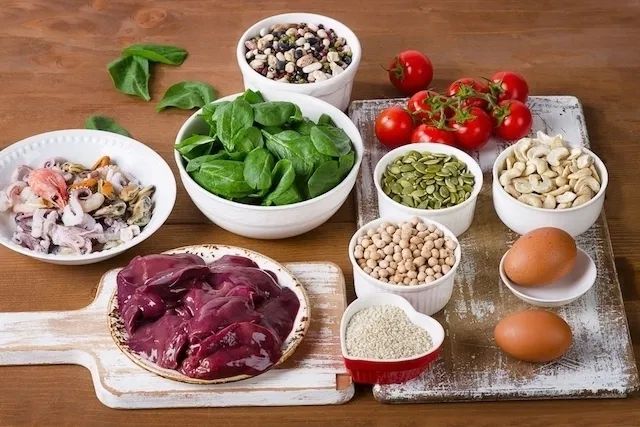Some iron-rich foods include beef, chicken, fish and seafood. Iron can also be found in many plant-based options, like pumpkin seeds, raisins and pistachios.
Iron is a mineral that is essential the production of hemoglobin, a component of red blood cells that is responsible for transporting oxygen. Iron also improves mood and strengthens the immune system.
Iron-rich foods should be eaten at all stages of life, and should be especially prioritize by pregnant women, older adults and babies, as these populations have a greater need for this mineral.

Benefits of iron
The main health benefits of consuming iron are:
- Preventing anemia, as iron participates in the production of hemoglobin, one of the components of red blood cells that transports oxygen from the lungs to the entire body and which is normally reduced in anemia;
- Boosting immunity, because it plays a role in immune cell functioning, such as neutrophils and macrophages;
- Improving mood, as iron is part of myoglobin, a protein that transports and stores oxygen in muscles to increase physical capacity.
Furthermore, iron is also important for the healthy growth and development of children, and is essential for the production and functions of various hormones.
Also recommended: 7 Iron Deficiency Symptoms That Can Emerge with Low Iron Levels tuasaude.com/en/iron-deficiency-symptomsIron sources and nutritional facts
There are two types of iron: heme-iron, which can be found from animal sources, and non-heme iron, which can be found in plant-based sources and iron-fortified food.
Iron-rich food from animal sources
The following table outlines the amount of iron in 100 g of each food source:
Iron-rich for from plant-based sources
The following table outlines the amount of iron found in 100 g of each plant-based food source:
Iron absorption from plant-based food sources is very low, therefore it is important to consume these foods with a vitamin C source, like oranges, pineapple, strawberries and peppers. Check-out a complete list of vitamin C foods that you can consume with your iron-rich foods.
[articleLink_simple:fruits-high-in-iron]
How to improve iron absorption
When eating iron rich foods, you may want to consider the following tips to ensure optimal absorption:
- Avoid eating calcium-rich foods during your main meals, like yogurt, pudding, milk or cheese, as calcium naturally inhibits the absorption of iron
- Avoid consuming sweets, red wine, chocolate and some teas, as some phytates and polyphenols can inhibit iron absorption
- Cooking in iron pots is a way of increasing iron content in low iron foods, like rice
Mixing fruits with vegetables in smoothies can also be a great way to increase the iron in your diet. Pineapple blended with parsley is an excellent iron source.
Daily recommended amount
The daily recommended dose of iron varies with age and gender, as seen in the table below. Women have a higher need for iron, especially during pregnancy.
Daily iron needs increase during pregnancy due to an increase in the volume of blood in the body. More red blood cells are needed for the development of the baby and the placenta, which is why more iron is required. Ensuring daily iron doses are met during pregnancy is very important, and supplementation may be advised by a doctor. Read more about iron supplements and how to take them.
